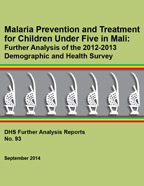- PUBLICATIONS
- JOURNAL ARTICLES
- ACCESS PUBLICATIONS
Publications Summary
- Document Type
- Further Analysis
- Publication Topic(s)
- Child Health and Development, Malaria
- Country(s)
- Mali
- Survey
- Mali DHS, 2012-13
- Language
- English,French
- Recommended Citation
- Castle, Sarah, Rachel Scott, and Soumalia Mariko. 2014. Malaria Prevention and Treatment for Children Under Five in Mali: Further Analysis of The 2012-13 Demographic and Health Survey. DHS Further Analysis Reports No. 93. Rockville, Maryland, USA: ICF International.
- Download Citation
- RIS format / Text format / Endnote format
- Publication Date
- September 2014
- Publication ID
- FA93
Download
 Malaria Prevention and Treatment for Children Under Five in Mali: Further Analysis of the 2012-13 Demographic and Health Survey (PDF, 1059K)
Malaria Prevention and Treatment for Children Under Five in Mali: Further Analysis of the 2012-13 Demographic and Health Survey (PDF, 1059K)
